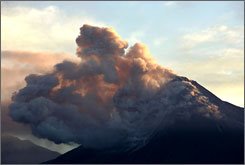Mount Merapi eruption brings back horror
Posted 5/16/2006 2:30 PM ET
E-mail Save Print var tempshowReprintSSI = "";
if(window.showReprintSSI)
{
tempshowReprintSSI = showReprintSSI;
}
if ((navigator.os.indexOf("Mac")==1) && (navigator.type==2))
{ // macIE
if((document.forms.hiddenValForm.hiddenMacPrintValue.value == "0") (document.forms.hiddenValForm.hiddenMacPrintValue.value=="2"))
{
if(document.forms.hiddenValForm.hiddenMacPrintValue.value == "2"){
document.forms.hiddenValForm.hiddenMacPrintValue.value = "0";
}
else{
document.forms.hiddenValForm.hiddenMacPrintValue.value = "1";
}
if(tempshowReprintSSI == 'showReprintSSI'){
writeReprintLink();
}
writeSubscribeToLink();
}
else
{
document.forms.hiddenValForm.hiddenMacPrintValue.value = "2";
}
}
else
{// non macIE - write top and bottom
if(tempshowReprintSSI == 'showReprintSSI'){
writeReprintLink();
}
writeSubscribeToLink();
}
function writeReprintLink(){
document.write('
Reprints & Permissions ');
}
function writeSubscribeToLink(){
var url = document.location.toString();
var urlArray = url.split("/")
var nurl = "";
for (i = 3; i
');
}
Subscribe to stories like this EnlargeBy Ed Wray, AP
Mount Merapi, in the middle of Indonesia's Java island, continues spewing lava and gas clouds Tuesday.
swapContent('firstHeader','applyHeader');
MOUNT MERAPI, Indonesia (AP) — The sky went black and a thunder-like roar filled the air. Some witnesses remember hearing one or two explosions. But few had time to see the searing hot gas cloud surge from the volcano before it engulfed their village, incinerating 60 people.
That was in 1994. Now, with Indonesia's Mount Merapi again emitting lava and gas clouds, survivors of the last eruption a dozen years ago told of its horrors — and urged people resisting evacuation this time to flee the danger zone.
"The trees caught fire and everything fell down" in 1994, said Maryoto, who sustained massive burns to his face and body. "I was aware of what was happening, but couldn't feel anything. It was so hot." Like many Indonesians, Maryoto uses one name.
The volcano in the middle of Java island continued spewing lava and gas clouds Tuesday, but not as violently or often as a day earlier, which saw the most activity since the peak began erupting again several weeks ago.
The relative lull did not mean the danger was over, scientists cautioned.
"That is Merapi," said Ratdomopurbo, the region's chief vulcanologist. "She is always fluctuating."
Scientists monitoring Merapi say the current activity will not result in a massive horizontal explosion, but warn that villagers living high on its slopes are again at risk of pyroclastic flows.
The flows are made up of a lower layer of coarse rock fragment, that bursts forth like a shotgun blast. The top layer is composed of turbulent ash and volcanic gas. They move together at speeds of 50 to 100 mph, and reach temperatures of up to 1,500 degrees.
Like most victims on the morning of Nov. 22, 1994, Maryoto was at a wedding in Turgo village on the mountain's western slopes when the 9,800-foot peak erupted.
He was in the kitchen and was trapped under one of its walls, perhaps shielding him from the heat and saving his life.
Maryoto, 50, lost nine family members, including his younger brother.
The intense heat melted both his ears, and many of his fingers and toes.
His wife, Kasiyem, was selling vegetables in the market when the volcano erupted. She was unharmed. When it was finally safe to return home, she said, she saw bodies that were "black, scorched — just like pieces of coal."
The pair now live with 120 other survivor families in a cul-de-sac the government built especially for them. It lies 2 1/2 miles below their old village, far enough from the peak to be considered safe.
Turgo has since been repopulated, but has been off-limits since Saturday, when the government ordered the evacuation of its inhabitants, along with about 5,000 other people closest to the crater.
Officials are manning barricades on the roads leading to the evacuation zone, stopping vehicles from entering. However, they let residents return to their fields and livestock during the day.
A few young men are allowed to stay in the villages overnight to guard against thieves.
But some people are refusing to leave at all, citing mystical beliefs that spirits watch over the volcano and will warn them if there is any danger.
"You can buy possessions, but you can't replace lives," said Kasiyem in an interview on the porch of the couple's two-room house. "They should come down."
Other survivors of the 1994 eruption said the mountain showed no sign of increased activity beforehand and that they received no warnings from the government's volcanology center.
The sight of more clouds on the mountain — locally called "shaggy sheep clouds" because they resemble tightly curled balls of wool as they roll down the slopes — has stirred bad memories for many.
"My friends said come and look at them (the clouds)," said Poniyem, who lost her 3 1/2-year-old son and her mother and father in the disaster, and was badly burned on her legs, hands and back. "I said to them, 'No way,' and stayed in the house."
Copyright 2006 The Associated Press. All rights reserved. This material may not be published, broadcast, rewritten or redistributed.
 Tugas Remidi Bahasa Inggris Kelas XI SMA Dr Soetomo Surabaya (Bu Anima) adalah membuat laporan dalam Bahasa Inggris mengenai Aktivitas Gunung Merapi saat ini Kemudian postkan dengan cara mengikuti lembar panduan yang diberikan.
Tugas Remidi Bahasa Inggris Kelas XI SMA Dr Soetomo Surabaya (Bu Anima) adalah membuat laporan dalam Bahasa Inggris mengenai Aktivitas Gunung Merapi saat ini Kemudian postkan dengan cara mengikuti lembar panduan yang diberikan. Kangaroo Island is fresh air, pristine beaches and dramatic scenery. It’s also one of the best places in Australia to see wildlife in the wild. Cycling, diving, farming, walking, four-wheel drive tours and fishing all adhere to the rules of eco-friendly treatment. Walk close to wildlif
Kangaroo Island is fresh air, pristine beaches and dramatic scenery. It’s also one of the best places in Australia to see wildlife in the wild. Cycling, diving, farming, walking, four-wheel drive tours and fishing all adhere to the rules of eco-friendly treatment. Walk close to wildlif
